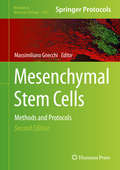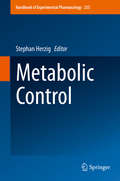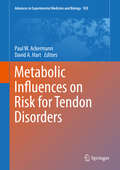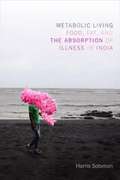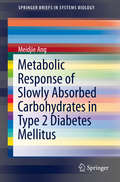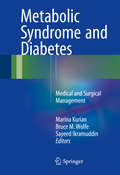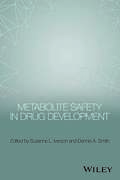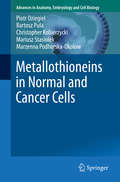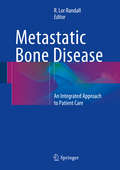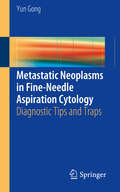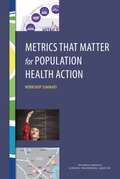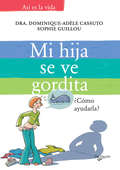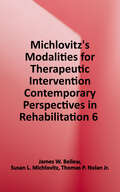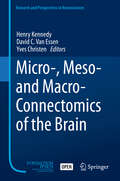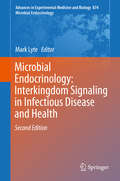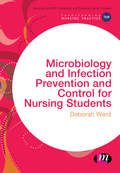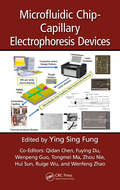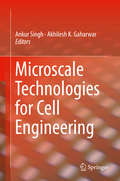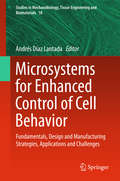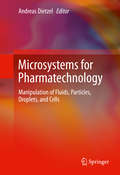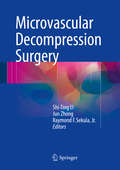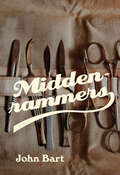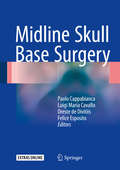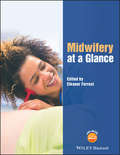- Table View
- List View
Mesenchymal Stem Cells
by Massimiliano GnecchiThis volume aims to outline the current status of the Mesenchymal Stem Cells(MSC) field in regenerative medicine and to propose clear and reproducible protocols to better define the identity, function and use of these cells that are today, more than ever, "under the spotlight". Mesenchymal Stem Cells: Methods and Protocols, Second Edition is organized into four sections. The first guides the reader through a series of state-of-the-art reviews summarizing the use of MSC for the treatment of various diseases. The other three sections are a collection of methodological chapters covering several aspects: isolation and characterization of MSC; expansion of MSC for clinical use; production and characterization of the MSC secretome. Written in the highly successful Methods in Molecular Biology series format, the method chapters include introductions to their respective topics, complete lists of the necessary materials and reagents, step-by-step, readily reproducible laboratory protocols, and tips on troubleshooting which will help the researcher to avoid known pitfalls. Authoritative and cutting-edge, Mesenchymal Stem Cells: Methods and Protocols, Second Edition, aims to ensure successful results in the further study of this vital field.
Metabolic Control
by Stephan HerzigThe HEP issue on Metabolic Control provides a state-of the art overview over both classical concepts and emerging areas in metabolism and associated disorders. In this context, metabolic control is highlighted at various levels of complexity ranging from transcriptional mechanisms in metabolic pathway control over metabolic communication routes in physiology and pathophysiology to current treatment modalities and options in metabolic disorders, including type 2 diabetes and obesity. Dedicated chapters by leading experts in their fields provide a concise overview over important areas in metabolic research at a molecular level, including the role of the central nervous system in metabolism, inflammation and metabolism, pancreatic hormone signaling, brown adipose tissue, and therapeutic concepts.
Metabolic Influences on Risk for Tendon Disorders
by Paul W. Ackermann David A. HartThis book will be of considerable interest to students, practitioners (Doctors, Physiotherapists) and researchers who deal with the complex structures of tendons and tendon disorders. The book is divided into three sections: (1) Basic Biology; (2) Metabolic Disorders; and (3) Biochemical Markers and Tendon disorders. The first section, devoted to the basic biology of tendons, is aimed at those people who want to learn and gain basic information on tendons. The section on metabolic disorders will mainly be aimed at practitioners who need to know how to treat their patients. Finally, the section on biochemical markers is chiefly aimed at the researchers who are planning new studies within this field.
Metabolic Living: Food, Fat, and the Absorption of Illness in India
by Harris SolomonThe popular narrative of "globesity" posits that the adoption of Western diets is intensifying obesity and diabetes in the Global South and that disordered metabolisms are the embodied consequence of globalization and excess. In Metabolic Living Harris Solomon recasts these narratives by examining how people in Mumbai, India, experience the porosity between food, fat, the body, and the city. Solomon contends that obesity and diabetes pose a problem of absorption between body and environment. Drawing on ethnographic fieldwork carried out in Mumbai's home kitchens, metabolic disorder clinics, food companies, markets, and social services, he details the absorption of everything from snack foods and mangoes to insulin, stress, and pollutants. As these substances pass between the city and the body and blur the two domains, the onset and treatment of metabolic illness raise questions about who has the power to decide what goes into bodies and when food means life. Evoking metabolism as a condition of contemporary urban life and a vital political analytic, Solomon illuminates the lived predicaments of obesity and diabetes, and reorients our understanding of chronic illness in India and beyond.
Metabolic Response of Slowly Absorbed Carbohydrates in Type 2 Diabetes Mellitus
by Meidjie AngThis SpringerBrief focuses on clinical nutrition research, particularly on the effects of slowly absorbed carbohydrates on postprandial glucose metabolism in type 2 diabetes. Slowlyabsorbed carbohydrates will cause gradual increases in blood glucose and insulin levels, and may therefore be effective as part of a treatment strategy for glycemic control and reduction of cardiovascular complications in type 2 diabetes.
Metabolic Syndrome and Diabetes
by Marina Kurian Bruce M. Wolfe Sayeed IkramuddinThis book provides a concise, state-of-the art review of the surgical treatment of metabolic syndrome and diabetes mellitus. The volume reviews what current practices in surgery and metabolic syndrome and diabetes including the biohormonal effects of the different surgeries. Isolating the effects of the different procedures is critical to the decision tree for type of procedure selected for an individual patient. Specifically for diabetes, this textbook will provide a guide for practitioners to a tailored approach to the treatment. Areas of ongoing research that highlight the minimally invasive approach as well as incorporating what we know of the biochemical results of surgery are presented. Results of established weight loss procedures and ongoing trials are juxtaposed against some of the more novel techniques to ascertain a best practice. Metabolic Surgery and the Surgical Treatment of Diabetes serves as a very useful resource for physicians and researchers dealing with, and interested in, this rising epidemic of metabolic syndrome and diabetes. It provides a concise yet comprehensive summary of the current status of the field that will help guide patient management and stimulate investigative efforts.
Metabolite Safety in Drug Development
by Dennis A. Smith Suzanne L. IversonA reference on drug metabolism and metabolite safety in the development phase, this book reviews the analytical techniques and experimental designs critical for metabolite studies. It features case studies of lessons learned and real world examples, along with regulatory perspectives from the US FDA and EMA.* Reviews the analytical techniques and experimental designs critical for metabolite studies* Covers methods including chirality, species differences, mass spectrometry, radiolabels, and in vitro / in vivo correlation* Discusses target pharmacology, in vitro systems aligned to toxicity tests, and drug-drug interactions* Includes perspectives from authors with firsthand involvement in industry and the study of drug metabolites, including viewpoints that have influenced regulatory guidelines
Metallothioneins in Normal and Cancer Cells
by Piotr Dziegiel Bartosz Pula Christopher Kobierzycki Mariusz Stasiolek Marzenna Podhorska-OkolowThis book describes the structures of Metallothionein (MT) family members and the cellular functions of MT-1, MT-2 and MT-4 isoforms, as well as provides insights into divergent biological roles of MT-3. The authors explain the involvement of MT molecules in various processes related to carcinogenesis, including an organ-specific presentation of current data concerning their potential impact on the progression of various tumors and the regulatory role of MT family members in the function of the immune system.
Metastatic Bone Disease
by R. Lor RandallProviding an integrated approach to the diagnosis and management of patients with metastatic bone disease (MBD), this comprehensive text combines discussion of the pathobiology of the disease with the latest oncological and orthopedic treatment modalities. After opening with an examination of the epidemiology and impact of MBD, the biology of bone metastases are discussed, along with considerations of the tissue of origin. Evaluation, biopsy and medical therapy, including metabolic agents and bio targeting. The heart of the book presents oncological approaches (supportive, radiation and interventional) and principles of orthopedic surgical oncology, with subsequent chapters covering specific anatomy, from the pelvis to the lower extremity and the spine. Chapters on emerging surgical technology and future directions conclude the text and redefine an integrated approach to patient care. Taken together, Metastatic Bone Disease is an excellent resource for orthopedic surgeons and cancer specialists alike.
Metastatic Neoplasms in Fine-Needle Aspiration Cytology
by Yun GongThis book focuses primarily on the most efficient way to make an accurate FNA diagnosis of metastatic tumors within the broad confines of cytopathology. The text provides a step-by-step "thought process" during the diagnostic approach of the metastatic tumors using detailed algorithms. Starting from the onsite immediate FNA sample assessment, the book provides strategy of specimen triage to facilitate further cytology evaluation based on the metastatic patterns and morphologic patterns of the tumors. In the subsequent chapter, the book provides tips and traps of selecting markers and interpretation of immunoperoxidase, flow cytometric, cytogenetic and molecular studies. The book includes the strategy of dealing with limited FNA material and wisely use existing samples (cell block, direct smear, cytospin) for different ancillary studies including molecular tests that have been used at MD Anderson. The author highlights challenging issues to show the importance of using a multidisciplinary (clinical, radiologic, cytologic and ancillary studies) approach. Extensive illustrations are provided. Metastatic Neoplasms in Fine-Needle Aspiration Cytology will provide pathology residents, fellows, practicing cytopathologists and cytotechnologists with a practical way to approach metastatic malignancies in daily cytology practice as well as provide a vision of the future of cytopathology.
Metrics That Matter for Population Health Action: Workshop Summary
by Engineering Medicine National Academies of SciencesIn times of rapid change and constrained resources, measures that are important, focused, and reliable are vital. However there is an overabundance of measures available for evaluating various aspects of population health and previous efforts to simplify existing sets to meet the needs of all decision makers have been unsuccessful. The National Academies of Sciences, Engineering, and Medicine convened a workshop to explore the status and uses of measures and measurement in the work of improving population health. Participants explored existing and emerging population health metric sets and characteristics of metrics necessary for stakeholder action across multiple sectors. This report summarizes the presentations and discussions from the workshop.
Mi hija se ve gordita
by Dra. Dominique-Adèle Cassuto Sophie GuillouLa dictadura de la línea hace estragos. En la adolescencia, cuando es habitual y frecuente que el cuerpo se redondee temporalmente, el tema se convierte en una catástrofe. El resultado es que nuestras hijas empiezan dietas de adelgazamiento descabelladas, que ponen en peligro su salud y su crecimiento. Este libro responde a las numerosas preguntas sobre el tema: * Cómo ayudarla a distanciarse un poco de la locura del adelgazamiento. * Qué papel deben desarrollar los padres, y en especial la madre. * ¿Es bulimia o picoteo? * Cómo reaccionar si su exceso de peso está solo en su cabeza. * Cómo transmitirle buenos hábitos alimentarios. * Cómo ayudarla a mantener o perder peso, evitando la trampa de las dietas demasiado restrictivas. * Qué hacer si tiene sobrepeso de verdad. Dominique-Adèle Cassuto doctora nutricionista, recibe todos los días a adolescentes que se lamentan de su peso, con o sin razón. Sophie Guillou periodista. Es coautora, junto a Ginette Lespine, de Surmonter le chômage en famille, de la misma colección.
Michlovitz's Modalities for Therapeutic Intervention (Contemporary Perspectives in Rehabilitation)
by James W. Bellew Susan L. Michlovitz Thomas P. NolanHere's a current, concise, and evidence-based approach to the selection, application, and biophysical effects of therapeutic modalities in a case-based format with a wealth of photographs and figures. <p><p> The 6th Edition builds and expands on the strengths of previous editions and their focus on expanding and strengthening clinical decision-making skills through a hands-on, problem-solving approach.
Micro-, Meso- and Macro-Connectomics of the Brain
by Yves Christen Henry Kennedy David C. Van EssenThis book has brought together leading investigators who work in the new arena of brain connectomics. This includes 'macro-connectome' efforts to comprehensively chart long-distance pathways and functional networks; 'micro-connectome' efforts to identify every neuron, axon, dendrite, synapse, and glial process within restricted brain regions; and 'meso-connectome' efforts to systematically map both local and long-distance connections using anatomical tracers. This book highlights cutting-edge methods that can accelerate progress in elucidating static 'hard-wired' circuits of the brain as well as dynamic interactions that are vital for brain function. The power of connectomic approaches in characterizing abnormal circuits in the many brain disorders that afflict humankind is considered. Experts in computational neuroscience and network theory provide perspectives needed for synthesizing across different scales in space and time. Altogether, this book provides an integrated view of the challenges and opportunities in deciphering brain circuits in health and disease.
Microbial Endocrinology: Interkingdom Signaling in Infectious Disease and Health
by Mark LyteThis new edition highlights the numerous advances made in the field of microbial endocrinology over the last five years. Prominent among these new topics featured is the emergence of the microbiota-gut-brain axis and the role it plays in brain function. Specific focus is given to the role of microbial endocrinology in the evolutionary symbiosis between man and microbe as it relates to both health and disease. With new chapters on the microbiome and its relation to neurochemicals, this new edition brings this important volume up to date.
Microbiology and Infection Prevention and Control for Nursing Students (Transforming Nursing Practice Series)
by Deborah WardPreventing and controlling infection has long been an on going challenge for all healthcare workers at every level. High profile examples like the Ebola outbreak in West Africa or the prevalence of ‘super bugs’ like MRSA demonstrate that this challenge is not going to go away. As a nurse you have a responsibility to protect your patients from harm and preventing and controlling infection is a crucial component of this. By introducing the unpinning microbiology to explain how infection occurs and spreads and the practical steps and precautions that you need to follow, this book will equip you with the knowledge and information necessary to play your part in preventing and controlling infection. Key features: · Written specifically for pre-registration nursing students providing the core, evidence-based knowledge that you need to know · Breaks the science down using easy-to-follow language, practical examples and case studies · Applies microbiology to practice introducing practical steps, precautions and strategies that will benefit you as soon as you get onto your placements · Includes multiple-choice questions to test your understanding and activities to help you engage with wider issues around infection prevention and control. About the author Deborah Ward is a lecturer at the School of Nursing, Midwifery and Social Work, Manchester University.
Microbiology and Infection Prevention and Control for Nursing Students (Transforming Nursing Practice Series)
by Deborah WardPreventing and controlling infection has long been an on going challenge for all healthcare workers at every level. High profile examples like the Ebola outbreak in West Africa or the prevalence of ‘super bugs’ like MRSA demonstrate that this challenge is not going to go away. As a nurse you have a responsibility to protect your patients from harm and preventing and controlling infection is a crucial component of this. By introducing the unpinning microbiology to explain how infection occurs and spreads and the practical steps and precautions that you need to follow, this book will equip you with the knowledge and information necessary to play your part in preventing and controlling infection. Key features: · Written specifically for pre-registration nursing students providing the core, evidence-based knowledge that you need to know · Breaks the science down using easy-to-follow language, practical examples and case studies · Applies microbiology to practice introducing practical steps, precautions and strategies that will benefit you as soon as you get onto your placements · Includes multiple-choice questions to test your understanding and activities to help you engage with wider issues around infection prevention and control. About the author Deborah Ward is a lecturer at the School of Nursing, Midwifery and Social Work, Manchester University.
Microfluidic Chip-Capillary Electrophoresis Devices
by Ying Sing FungCapillary electrophoresis (CE) and microfluidic chip (MC) devices are relatively mature technologies, but this book demonstrates how they can be integrated into a single, revolutionary device that can provide on-site analysis of samples when laboratory services are unavailable. By introducing the combination of CE and MC technology, Microfluidic Ch
Microscale Technologies for Cell Engineering
by Ankur Singh Akhilesh K. GaharwarThis book offers readers cutting-edge research at the interface of polymer science and engineering, biomedical engineering, materials science, and biology. State-of-the-art developments in microscale technologies for cell engineering applications are covered, including technologies relevant to both pluripotent and adult stem cells, the immune system, and somatic cells of the animal and human origin. This book bridges the gap in the understanding of engineering biology at multiple length scale, including microenvironmental control, bioprocessing, and tissue engineering in the areas of cardiac, cartilage, skeletal, and vascular tissues, among others. This book also discusses unique, emerging areas of micropatterning and three-dimensional printing models of cellular engineering, and contributes to the better understanding of the role of biophysical factors in determining the cell fate. Microscale Technologies for Cell Engineering is valuable for bioengineers, biomaterial scientists, tissue engineers, clinicians, immunoengineers, immunologists and stem cell biologists, as it offers a review of the current cutting-edge cell engineering research at multiple length scale and will be valuable in developing new strategies for efficient scale-up and clinical translation.
Microsystems for Enhanced Control of Cell Behavior
by Andrés Díaz LantadaThis handbook focuses on the entire development process of biomedical microsystems that promote special interactions with cells. Fundamentals of cell biology and mechanobiology are described as necessary preparatory input for design tasks. Advanced design, simulation, and micro/nanomanufacturing resources, whose combined use enables the development of biomedical microsystems capable of interacting at a cellular level, are covered in depth. A detailed series of chapters is then devoted to applications based on microsystems that offer enhanced cellular control, including microfluidic devices for diagnosis and therapy, cell-based sensors and actuators (smart biodevices), microstructured prostheses for improvement of biocompatibility, microstructured and microtextured cell culture matrices for promotion of cell growth and differentiation, electrophoretic microsystems for study of cell mechanics, microstructured and microtextured biodevices for study of cell adhesion and dynamics, and biomimetic microsystems (including organs-on-chips), among others. Challenges relating to the development of reliable in vitro biomimetic microsystems, the design and manufacture of complex geometries, and biofabrication are also discussed.
Microsystems for Pharmatechnology
by Andreas DietzelThis book provides a comprehensive, state-of-the-art review of microfluidic approaches and applications in pharmatechnology. It is appropriate for students with an interdisciplinary interest in both the pharmaceutical and engineering fields, as well as process developers and scientists in the pharmaceutical industry. The authors cover new and advanced technologies for screening, production by micro reaction technology and micro bioreactors, small-scale processing of drug formulations, and drug delivery that will meet the need for fast and effective screening methods for drugs in different formulations, as well as the production of drugs in very small volumes. Readers will find detailed chapters on the materials and techniques for fabrication of microfluidic devices, microbioreactors, microsystems for emulsification, on-chip fabrication of drug delivery systems, respiratory drug delivery and delivery through microneedles, organs-on-chip, and more.
Microvascular Decompression Surgery
by Jr. Shi-Ting Li Jun Zhong Raymond F. SekulaThis book provides an essential update on microvascular decompression (MVD) surgery, which has been widely accepted as an effective remedy for cranial nerve hyperexcitability disorders such as hemifacial spasm, trigeminal neuralgia, glossopharyngeal neuralgia, etc. The authors describe in detail those steps of the process that need the most attention in order to achieve an excellent postoperative outcome, including positioning, craniectomy, approach and identification of the culprit, etc. Though it primarily focuses on surgical principles and technical nuances, the book also addresses the intraoperative electrophysiologic monitoring and pathogeneses of hemifacial spasm and trigeminal neuralgia.
Middenrammers
by John BartMiddenrammers is a brave and provocative novel about one doctor’s battle for social justice in a small-town hospital. Set in the UK in the 1970s, the story follows young Dr. Brian Davis’ efforts to adjust to his new job in a Yorkshire fishing town. The town’s only hospital permits no contraceptive advice, or abortions. Dr. Davis and Woodie — the midwife he falls in love with — regularly come face to face with the terrible repercussions of these policies. Because they refuse to accept the attitude of the hospital administrators — who believe that the right thing to do is to restrict choice and deny reproductive options — the course of their lives is changed as much as those of the patients.
Midline Skull Base Surgery
by Oreste De Divitiis Paolo Cappabianca Luigi Maria Cavallo Felice EspositoThis richly illustrated book offers detailed, step-by-step guidance on surgical approaches and techniques in patients with midline tumors of the skull base. Access routes are described from both endoscopic and microscopic standpoints, via different approaches, in order to provide a 360-degree overview of contemporary midline skull base surgery. For each pathology, the multiple surgical options and their specific indications are clearly presented, with inclusion of neuroradiological images, an anatomical dissection study and operative images and videos. The book is intended for surgeons who wish to acquire knowledge and experience in skull base surgery employing endoscopic endonasal and microsurgical transcranial techniques. It is exceptional in providing an integrated perspective that encompasses traditional microsurgical approaches and the most recent endoscopic ones, with definition of the indications for and limitations of both options.
Midwifery at a Glance (At a Glance (Nursing and Healthcare))
by Eleanor ForrestMidwifery at a Glance offers an easy-to-read yet comprehensive overview of everything a midwifery student needs to know, from conception to care of the newborn. This practical guide provides coverage of normal pregnancy, maternal and foetal physiology, and pre-existing medical conditions and how these affect pregnancy and birth. It also features vital information on the role of the midwife, evidence-based practice, health promotion education, and perinatal mental health, as well as neonatal care and an overview of emergency situations. Midwifery at a Glance: Contains superb full colour illustrations throughout Is written specifically for midwifery students and includes all the concepts found on the midwifery curriculum Demonstrates links with other relevant multidisciplinary healthcare professionals Midwifery at a Glance is the ideal guide, offering educational support for midwifery students in the application of midwifery knowledge into clinical practice.
